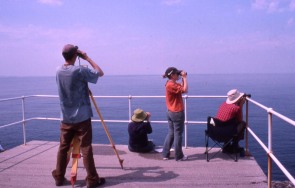Sightings Index


Watching Cetaceans
Whether or not you see whales, dolphins or porpoises is largely dependent on the weather. If it is a windy day with whitecaps on the water it is much harder to spot cetaceans, as they often only surface briefly and usually only show their dorsal fins. Too much sunshine doesn't help either, as the reflection on the water makes it really difficult to see anything that breaks the surface; overcast and calm days are the best to see marine mammals.
Scanning the water for anything that disturbs the surface can be done with the naked eye or binoculars. Signs of cetaceans can be as simple as fins breaking the surface, or an animal jumping out of the water, but also look for splashes, or waves that look like they are breaking the wrong way. An extremely flat patch of water (known as a ‘footprint’) may be a sign that a cetacean has just dived. On sunny days, the light can also be reflected off the shiny skin of a cetacean, which can catch your eye if you’re paying attention. Be aware of the phenomenon that after a while every wavelet will appear to be a dorsal fin; this happens to even the most experienced observers!
It is always useful to keep an eye on feeding seabirds. If there are many of them diving franticly in one particular spot (known as a ‘hurry’), this could mean that the fish have been rounded up to the surface into a bait ball by a larger predator such as a minke whale, making it easy for the birds to dive in and join the feast. Keep watching and you may see a large arched back or maybe even a lunge feed, where a whale will lunge out of the water with its mouth open.
Although all these tips are useful, there is no guarantee that you will see a whale, a dolphin or a porpoise. They are elusive creatures and even the most experienced observers will be used to scanning the water for hours without seeing anything. However, enjoy the experience, for there are many other interesting things to see when looking for cetaceans. Seals, otters, many bird species and beautiful views are very rewarding, too. Finally, if you do see a whale, dolphin, or porpoise count yourself lucky, treasure the memory and please complete our online sightings form.
Where to see cetaceans
At sea
There are many tour operators throughout the Hebrides offering a wide range of different boat trips. HWDT recommends operators accredited by the WiSe scheme. The WiSe scheme encourages responsible wildlife watching by running training courses for boat operators. It promotes the Scottish Marine Wildlife Watching Code which was launched in 2006. This code aims to minimise disturbance to marine animals and encourages safe and sustainable wildlife watching.
On land
You don’t have to take to the high seas to find a whale. If you feel more at home on the shore, there are lots of sites in the Hebrides from which you can spot a whale, dolphin or porpoise. In general exposed headlands are best. These places provide a good vantage point, and are often also where tidal features such as eddies and tidal races concentrate prey, making them likely areas for cetaceans to come and feed. So anywhere with a lighthouse is often a good place to start, but here are a few suggestions:
- Ardnamurchan Point, Ardnamurchan Peninsula – minke whales and dolphins
- Iona Sound – bottlenose dolphins
- Tobermory Lighthouse, Mull – good for porpoise watching
- Neist Point, Skye – all cetaceans possible here
- Canna Harbour – minke whales and basking sharks
When?
The best time of year to watch cetaceans in the Hebrides is between April and September since many of our regularly sighted species are summer visitors to the area. Furthermore, the weather during the Spring and Summer months is more suitable for cetacean watching. View our recent sightings table.





